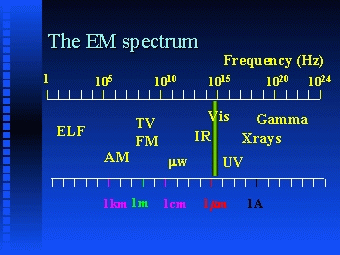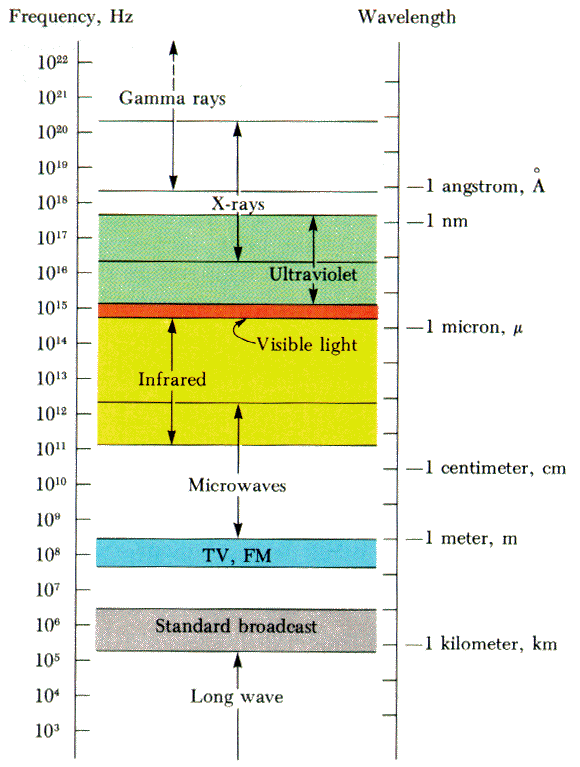
Light is electromagnetic radiation at those frequencies to which human eyes (and those of most other sighted species) happen to be sensitive. But the electromagnetic spectrum has no upper or lower limit of frequencies. It certainly has a much broader range of frequencies than the human eye can detect. In order of increasing frequency (and decreasing wavelength), the electromagnetic spectrum includes radio frequency (RF), infrared (IR, meaning “below red”), visible light, ultraviolet (UV, meaning “above violet”), X-rays, and gamma rays. These designations describe only different frequencies of the same phenomenon: electromagnetic radiation.
The frequencies shown in the following two diagrams are within range of those generated by common sources and observable using common detectors. Ranges such as microwaves, infrared, etc., overlap. They are categorized in spectrum charts by the artificial techniques we use to produce them.
Electromagnetic Spectrum:
Visible Light only a Fraction of the Spectrum
3EElectromagneti
I o
et

Frequency Bands
Electromagnetic radiation with frequencies between about 5 kHz and 300 GHz is referred to as radio frequency (RF) radiation. Radio frequencies are divided into ranges called “bands,” such as “S-band,” “X-band,” etc. Radio telescopes can be tuned to listen for frequencies within certain bands.
GBT Receivers
Receiver # Band Frequency Wavelength Polarization
Range (GHz) Range (cm)
______________________________________________________________________
P-1 0.68 - 0.92 32.6 - 44.1 Linear/Circular
P-2 0.51 - 0.69 43.5 - 58.8 Linear/Circular
P-3 0.39 - 0.52 57.7 - 76.9 Linear/Circular
P-4 0.29 - 0.40 75.0 - 103.4 Linear/Circular
1 L 1.15 - 1.73 17.3 - 26.1 Linear/Circular
2 S 1.73 - 2.60 11.5 - 17.3 Linear/Circular
3 S 2.60 - 3.95 7.6 - 11.5 Linear/Circular
4 C 3.95 - 5.85 5.1 - 7.6 Linear/Circular
5 C 5.85 - 8.20 3.7 - 5.1 Linear/Circular
6 X 8.00 - 10.00 3.0 - 3.7 Circular
7 X 10.00 - 12.40 2.4 - 3.0 Circular
8 Ku 12.00 - 15.40 1.9 - 2.5 Circular
9 Ku 15.40 - 18.00 1.7 - 1.9 Circular
10 K 18.00 - 22.00 1.4 - 1.7 Circular
11 K 22.00 - 26.50 1.1 - 1.4 Circular
12 Ka 26.50 - 33.00 0.9 - 1.1 Circular
13 33.00 - 40.00 0.75 - 0.9 Circular
14 Q 40.00 - 45.00 0.67 - 0.75 Circular
15 45.00 - 50.00 0.6 - 0.67 Circular